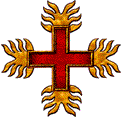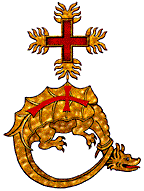|

The Order of
the Dragon (Lat: Societatis draconistrarum) was an
institution similar to other chivalric orders of the time,
modeled on the Order of St. George (1318). It was created in
1408 by the Holy Roman Emperor Sigismund (then the king of
Hungary). According to its statute, which survives in a copy
dated 1707, the Order required its initiates to defend the Cross
and fight its enemies, principally the Turks. The original Order
had twenty four members of the nobility, including such notable
figures as:
-
Sigismund of Luxembourg, King of Hungary, Emperor of Holy Roman Empire (after
1410)
-
Despot Stefan
Lazarevic of Serbia
-
King Alfonso V
of Aragon and Naples
-
King Vladislav Jagello of Poland
-
Grand Prince
Vitovd of Lithuania
-
Duke Ernst of
Austria
-
Christopher
III, Duke of Bavaria and King of Denmark
-
Thomas de
Mowbray, Duke of Norfolk (after 1439)
-
Vlad Tsepesh,
Duke of Wallachia (after 1431)

The Order of
the Dragon adopted as its symbol in 1408 the image of a circular
dragon with its tail coiled around its neck. On its back, from
the base of its neck to its tail, was the red cross of St George
on the background of a silver field. With the expansion of the
Order, other symbols were adopted, all variations on the theme
of dragon and cross. For example, one class of the Order used a
dragon being strangled with a cross draped across its back;
another presents a cross perpendicular to a coiled-up dragon
with an inscription:
"O quam
misericors est Deus" (Oh, how merciful God is)
and "Justus
et paciens" (Justifiably and peacefully)
Other emblems
of the Order included a necklace and a seal, each with a variant
form of the dragon motif.
After the
death of Sigismund in 1437, the Order of the Dragon lost much of
its prominence, though its iconography was retained on the
coats-of-arms of several noble families.

|
|
![]()